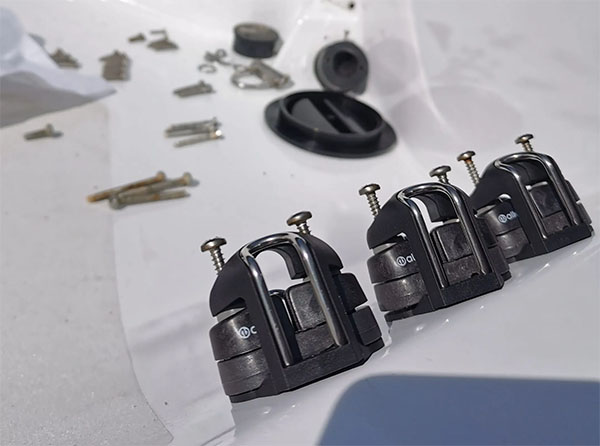Exploring Cam Cleats – Part 4: Maintenance and Care of Cam Cleats
Author: Allen Brothers Date Posted:25 October 2023
Part 4 of the fantastic series by Allen Brothers on Cam Cleats. This time around they are looking at the Maintenance and Care of Cam Cleats.
Welcome to the fourth and final chapter of our comprehensive blog series “Exploring Cam Cleats”. In Part 4, we shift our focus from the uses and functionality to the equally important realm of preserving and optimising the performance of your cam cleats.
 In this installment, we’ll unravel the mysteries of cleaning, inspecting and servicing cam cleats. With insights into proactive maintenance routines and best practices, you’ll be equipped to maintain your cam cleats in peak condition, ensuring that every sail is met with the reliability and performance you’ve come to expect from Allen hardware.
In this installment, we’ll unravel the mysteries of cleaning, inspecting and servicing cam cleats. With insights into proactive maintenance routines and best practices, you’ll be equipped to maintain your cam cleats in peak condition, ensuring that every sail is met with the reliability and performance you’ve come to expect from Allen hardware.
Whether you’re cruising leisurely or navigating a competitive race, the reliability of your cam cleats is crucial. Proper maintenance minimises the risk of unexpected malfunctions which could lead to losing a race or unwanted line handling issues.
Regular Cleaning
Dirt, salt, and debris have an insidious way of infiltrating the inner workings of cam cleats. These particles create friction, hindering the smooth operation of the cleat’s mechanism. A compromised cam cleat can struggle to grip lines securely, impairing your ability to maintain accurate line control.
We recommend, cleaning cam cleats (and other hardware!) with fresh water after every sail, especially when sailing on the sea or launching from a sandy beach.
To wash the cam cleat, simply dowse the cam cleat in fresh water and at the same time open and close the jaws by hand. This will ensure any loose grit or any build-up of salt is washed away from the internal mechanism.
NEVER use lubricant! There are several reasons for this. Firstly lubricant can actually make the ball bearings too slippery, meaning they won’t roll properly and can end up skidding. This can create flat spots on the ball bearings and lead to more friction when opening the jaw.
Secondly, grit and sand will stick to the lubricant. Which will create far more friction and additional wear to components as the parts grind over the grit or sand.
Inspecting for Wear and Damage
Inspecting a cam cleat for wear and damage is a critical aspect of maintenance to ensure the continued performance and safety of your sailboat. Regular inspections help identify issues early on, allowing you to address them before they escalate. Here’s how you can inspect a cam cleat for wear and damage:
Visual Examination:
Begin with a thorough visual inspection of the entire cam cleat. Look for signs of wear, such as visible scratches, dents, or corrosion on the cleat body and jaws.
Check the surface of the jaws for any irregularities, roughness, or deformities that may affect their gripping ability.
Examine the grooves or notches in the jaws where the line rests. Over time, these grooves can wear down due to friction. If you notice excessive wear, the jaws may struggle to grip the line effectively.
Spring Mechanism
Inspect the spring mechanism that controls the cam action. To check the spring is working correctly slowly open the cam jaws to the maximum open position, and then release them. The jaws should snap closed. If the jaws don’t close quickly or won’t close at all, then you have a broken spring. A worn or damaged spring can affect the cleat’s ability to grip the line securely.
Alignment and Engagement:
Check the alignment of the jaws when closed. They should meet evenly, without any gaps or misalignment. Proper alignment ensures effective gripping and prevents unintentional line slippage.
Fasteners and Mounting:
Examine the fasteners that secure the cam cleat to the boat. Ensure that they are tight and free from rust or corrosion. Check the mounting area for any cracks or damage that may affect the strength of the fixing.
Documentation:
Keep a maintenance log where you record the date of inspection, observations, and any maintenance tasks performed. This log will help you track the condition of your cam cleats over time.
Servicing
If you notice any issues with your Allen cam cleat, you can order a servicing kit to replace some of the components. Watch the video below to see how you can perform a full service on our aluminium cam cleat.
Thank you for joining us through this comprehensive blog post series, we embarked on a captivating journey through the world of cam cleats, their accessories, practical applications, and maintenance. As we dock at the conclusion of this voyage, let’s reflect on the key takeaways that will help you maximise the performance of your sailboat systems which utilise cam cleats.
